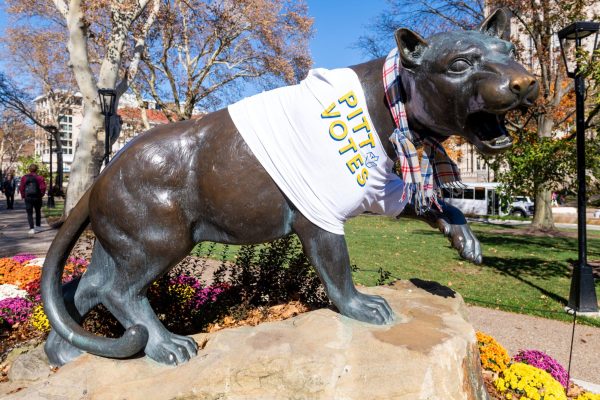Buddhism and Expressionism intersect
September 8, 2010
Mandalas & Deities
Mendelson Gallery
5874… Mandalas & Deities
Mendelson Gallery
5874 Ellsworth Ave.
Runs until Oct. 2
Wednesday-Saturday 12-5 p.m.
412-361-8664
At first glance, the inspirations for Harish Saluja’s art in the Mendelson Gallery might seem contradictory.
Buddhist mandalas derive from a long tradition of highly symbolic art. The outer circles represent gates to reach the center, a palace of meditation.
On the other hand, abstract expressionism began within the past 60 years in America as a way for artists to abandon conventions and instead paint with raw emotion.
But Saluja explained how both the practice of mandalas and the flow of expressionism fit with his philosophy of “freedom within boundaries.”
“There are certain things I would not do, like kill, steal, cheat or hurt someone intentionally,” he said. “But within those boundaries I refuse to listen to anybody. I will make fun of everybody and ridicule myself. I will break all the damn rules.”
Walking into the gallery, one can see how the two contrasting elements work together. A glowing, golden Buddha sits at the center of a canvas, emitting a sense of tranquility amidst the chaos of color that surrounds him. Nearby, the six points of a blue Star of David touch the outer edge of a circle, while a tree flourishes in the middle.
These religious images rarely reside together in one room, but in Saluja’s paintings all symbols of spirituality are equally embraced.
After nine years of struggling to find a new direction with his art, Saluja one day found himself painting a Buddhist mandala in the vein of his artistic discipline, abstract expressionism.
Although Saluja always had an interest in art, he actually started out as an engineer.
He earned his degree from one of the most prestigious schools in India, the Indian Institute of Technology, which 60 Minutes once described as “Harvard, MIT and Princeton together.”
There, his fascination with art was cultivated through various required classes in painting, theater and music. He worked for some years as an engineer, but was unfazed by his newly acquired material wealth.
So in 1971, he left India for Pittsburgh where he worked as an assistant publisher and began an Indian radio program on WDUQ.
Eventually, he left publishing and became a full-time artist, filmmaker and music aficionado.
His last series of paintings, called the Raga series, drew inspiration from Indian, jazz and classical music. But today he feels most closely drawn to the meaning behind the mandalas.
“I like the idea of the struggle of life, going through hoops to find internal contentment,” he said.
In some Buddhist rituals, the mandala is actually destroyed after it is created to represent the impermanence of life. For some artists this act would be devastating, but to Saluja the philosophy of letting go is quite beautiful.
“I wish I had the courage of destroying every painting that I did, but the gallery would have a fit, so I do keep some,” he said.
Along with the mandalas, he also paints images of Hindu deities, such as Saraswati, the goddess of arts and learning.
“She is described as a beautiful person, not because of her looks, but because she is a beautiful being. That is why I don’t put features on her face,” he said. “Every time I need inspiration I go ahead and paint a Saraswati.”
Although Saluja has an extensive knowledge of and reverence for the beliefs of many world religions, he does not claim affiliation with any one in particular.
“I have a very strong spiritual center, but I have trouble with organized religion,” he said.
Yet he consistently feels drawn to the image of Buddha — a man who never made claim to divine revelation, but rather asked his followers to pursue their own spiritual paths.
“If I have to make an image, I make man — not god — sitting under a tree, meditating on the state of human affairs and trying to find some peace and contentment in life,” he said.
Despite all of his many accomplishments, Saluja remains humble about the purpose of his art.
“I’m one of those clichéd people who thinks you can make a difference in the world, who thinks you need to give back and touch lives,” he said. “I know it’s stupid, but what you can do, it’s too late for me.”






